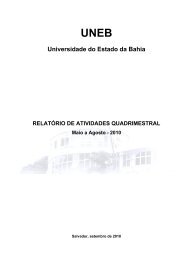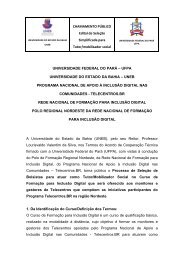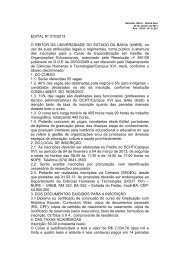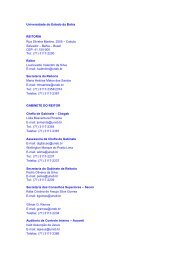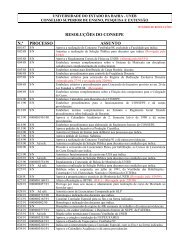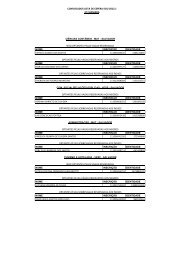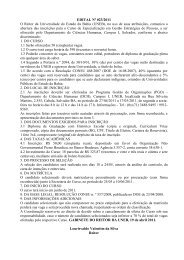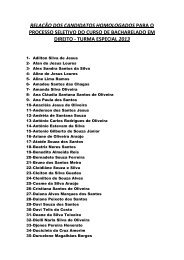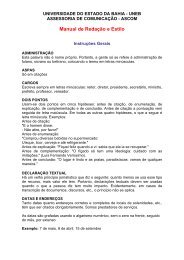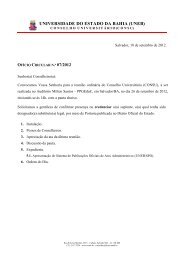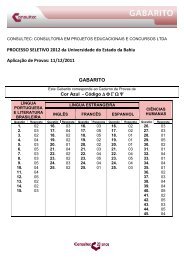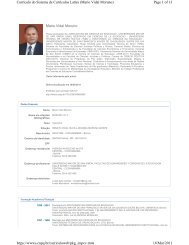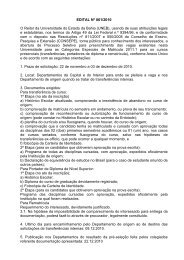Revista da FAEEBA Educação e Contemporaneidade - Uneb
Revista da FAEEBA Educação e Contemporaneidade - Uneb
Revista da FAEEBA Educação e Contemporaneidade - Uneb
Create successful ePaper yourself
Turn your PDF publications into a flip-book with our unique Google optimized e-Paper software.
In search of América: latina/os (re)constructing the U.S.A.<br />
240<br />
we gave birth<br />
to a new generation<br />
AmeRícan salutes all folklores,<br />
european, Indian, black, Spanish,<br />
and anything else compatible…<br />
(Tato Laviera, AmeRícan, 1985, p.94)<br />
Latina/os 1 have long been invisible in the collective<br />
U.S. imagination. Their “invisibility” changed<br />
forever on June 18, 2003, when the U.S.<br />
Census Bureau announced that U.S. Latina/os 2<br />
had reached a long-anticipated and symbolically<br />
significant milestone in the U.S.; Latinos were<br />
now the nation’s largest “minority,” displacing<br />
African Americans (EL NASSER, 2003). The<br />
news coverage on the significance of this event<br />
for understanding who we are as a nation spoke<br />
of Hispanics as if they were a monolithic population.<br />
Never mind that there is no pan-ethnic<br />
Latina/o identity and that the term “Latina/os”<br />
encompasses diverse groups, histories, generations,<br />
social classes, and even languages. And<br />
never mind that for Americans 3 in some parts of<br />
the nation the news was not exactly news –<br />
California, for instance, where as of July 4 2001 4<br />
over 50 percent of all babies born were already<br />
Hispanic (MURPHY, 2003). The nation had crossed<br />
a threshold that pointed beyond all doubt to<br />
the growing latinization of the population.<br />
In this chapter I examine the impact of the<br />
Latina/o presence in the U.S.A. through time,<br />
and the paradigms that they have challenged<br />
and/or helped undermine. Latinos have forced<br />
the nation to re-visit how the American West<br />
was “won” (and therefore how to characterize<br />
the building of the United States); to re-visit what<br />
constitutes “the” immigrant experience; to rethink<br />
how we see one another racially (beyond<br />
the black/white binary); and to re-conceptualize<br />
what constitutes the “border” and being<br />
“American” in an era characterized by increasing<br />
global interdependence.<br />
An Enduring – and Marginalized –<br />
Latina/o Presence<br />
Mexicans and Puerto Ricans, unlike their<br />
European counterparts, initially became part of<br />
the U.S.A. through conquest. The acquisition of<br />
Flori<strong>da</strong> in the early 1800s brought people with<br />
Spanish roots into the nation. The first significant<br />
numbers of Latina/os to become part of the<br />
American population, though, were incorporated<br />
through U.S. acquisition of Mexican lands in the<br />
mid-1800s. Mexico lost almost half of its land<br />
and three-quarters of its mineral resources in the<br />
mid-1800s to its powerful northern neighbor<br />
(GONZALEZ, 2000). Texas’ contrived secession<br />
and U.S. victory in the Mexican War were<br />
followed by the subsequent “purchase” from<br />
Mexico of what was to become the American<br />
Southwest. These acquisitions were a thin veneer<br />
for 19 th century U.S. imperialism. As one<br />
Chicana (Mexican American) poet put it, “No<br />
crucé la frontera, la frontera me cruzó a mí”<br />
(ROSALDO, 1997). These realities, however,<br />
run counter to the historical narrative traditionally<br />
taught in U.S. history texts, depicting the U.S. as<br />
a nation of immigrants moving east to west into<br />
seemingly uninhabited spaces.<br />
Mexicans in the U.S., while their experiences<br />
differed somewhat depending upon their<br />
state of residence, rapidly came to constitute a<br />
class of exploited laborers. Stigmatized, socially<br />
segregated, and politically marginalized, they<br />
1 This is a new term gaining popularity in the U.S. in order<br />
to include women (Latinas), also sometimes written as Latino/as.<br />
2 The umbrella terms “Latino” and “Hispanic” are often<br />
used interchangeably in the U.S. to refer to people of Latin<br />
American origin. “Hispanic” was introduced by the U.S.<br />
government in the 1970s, and then adopted in the 1980<br />
census to identify U.S. residents who trace their ancestry to<br />
Spanish-speaking regions of the world. “Latino” gained<br />
popularity in the 1980s and 1990s, largely because more<br />
politicized community members felt it affirmed their Latin<br />
American (and therefore racially mixed) origins rather than<br />
privileging their Spanish roots. As such, it also can embrace<br />
the growing Brazilian population now in the U.S. A recent<br />
survey by the Pew Hispanic Center revealed that only 24<br />
percent prefer to use the terms “Hispanic” or “Latino.”<br />
Overall 54 percent preferred to be identified by their country<br />
of origin—though among American-born Hispanics that<br />
dropped to 29 percent, with 46 percent preferring to be<br />
identified as “Americans” (BUSTOS, 2002).<br />
3 I acknowledge the problems with using this term to refer<br />
to only people of the USA. There is however no suitable<br />
substitute in English.<br />
4 There is a delicious irony here. July 4 is the <strong>da</strong>te that the<br />
13 original colonies (all on the east coast, and populated by<br />
European, African-origin peoples and Native Americans)<br />
declared independence from Britain.<br />
<strong>Revista</strong> <strong>da</strong> <strong>FAEEBA</strong> – <strong>Educação</strong> e Contemporanei<strong>da</strong>de, Salvador, v. 15, n. 25, p. 239-257, jan./jun., 2006



